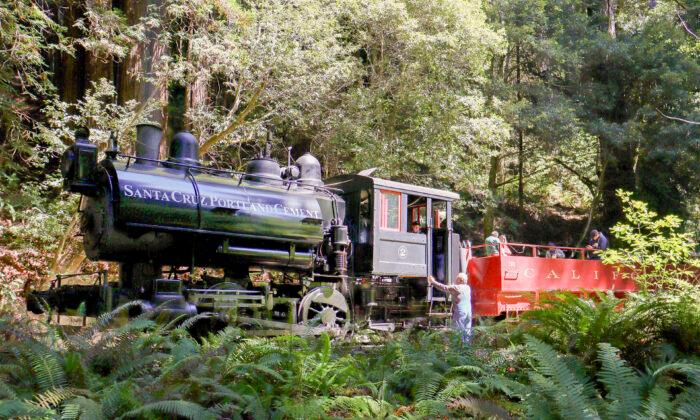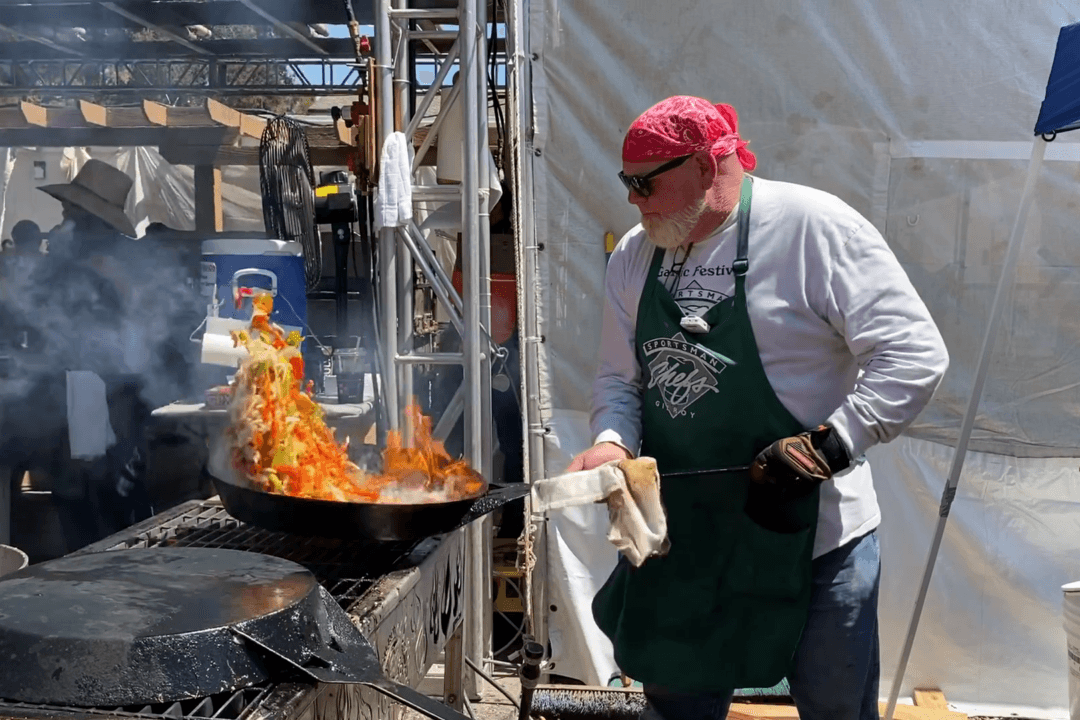FORT BRAGG, Calif.—Along Northern California’s coast, the world-famous Skunk Train attracts visitors to Fort Bragg from near and far.
A cheery man wearing glasses, blue overalls, a black T-shirt, and a black cap drives the steam train. He is Stathi Pappas, the Skunk Train’s general manager.
The Skunk Train line includes five historic trains and offers tours through the redwood forest, with special event trains running throughout the year.

“People love the steam locomotive; they love the history that it embodies, and it’s time to rebuild our own,” Pappas told NTD, a sister media of The Epoch Times.
Steam locomotives have fascinated Pappas since he was a boy. When he was studying to become an industrial archaeologist, he was struck with the idea to buy one.
In 2006, he walked into Pollardville’s Chicken Kitchen in Stockton, California and saw the locomotive painted as a circus train. It had served as a billboard for the restaurant for 30 years.
“I asked to speak to the owner, who happened to be Neil Pollard, and I asked, ‘Are you guys interested in selling this locomotive?’ And the answer was … at a price that was a little more than what I was going to be able to pay as a starving academic,” Pappas recalled.
But it didn’t take long for him to get his prize. Four months later, the locomotive was his—with a rubber chicken tied at the front to commemorate its origins.

He operates it with his fireman, John Graddon. Graddon explained to NTD that he keeps the water boiling at about 360 degrees to keep up the pressure and keep the train moving.
“The more pressure you have on the vessel, the more heat it takes to boil the water. The pressure brings the boiling point of the water up. The pressure is not what makes the locomotive run. It’s the expansion of letting the water vapor out of the boiler that actually moves the engine,” Graddon said.
It runs on recycled fuel oil and has done so since 1909. Graddon explained how he and Pappas work together to get the train going.
“He’s got the bar for direction, the throttle, and the brakes for the train and the engine that he’s controlling. So it’s a marriage between both sides. He has to have me to do his job. If he’s not doing his job, there’s no reason for me to do mine. So we work together to make everything happen, all in a balance,” Graddon said.

The Skunk Train’s peculiar name came from how bad its exhaust smelled in the old days.
“When the California Western Railroad bought its railbuses that were gasoline powered, everybody sort of derisively in the local community called it the Skunks,” Pappas said. “But the management at the time actually embraced that—it’s a good nickname. Okay, so you called it the Skunk; let’s make a logo of the skunk. So Mr. Skunk, the mascot, was created and it became the route of the Skunk, or later on, the Skunk Train.”
Pappas said the train line started in 1885 as a lumber-hauling railroad. It served as part of the Union Lumber Company. Over the years, the tracks stretched farther east until it connected to the city of Willits.
“This railroad was in many ways the lifeblood of the community here in Fort Bragg for so many decades. It hauled all the goods and services in from the outside world and hauled the timber out. That made most of the money until the lumber mill shut down in about 2002,” Pappas said.
It still carries freight, but its economy has changed to focus on passengers.
People discovered the beauty of the redwoods during the second half of the 20th century and started to ride the train for the scenery.

From the Fort Bragg station, visitors can go on an hour-long round trip through the redwood forest. The train moves at 15 miles per hour, so people can enjoy the scenery both inside and out. The cars date back to as early as the 1900s.
“So these are all very historic. The interiors—they have the original walkover seats in them. It’s an authentic experience of being on an old-time train,” Pappas said.
The train stops at Glen Blair Junction for about 20 minutes. There, people can wander through the forest and enjoy the quiet surroundings.
Railbikes are an alternative way to see the redwood forest. They share the rails with the trains.

“On the driver’s side … there’s a little black box up there. It’s a little motor,” Bruce Price, a railbike guide, told NTD. “So whenever a driver is pedaling, they can basically give them an electronic assist as they pedal.”
The railbikes weigh about 250 to 350 pounds. According to Price, anyone 3 and older can ride them—even 90-year-olds.
“There’s also a throttle; if we have people who don’t feel like pedaling or they can’t pedal for some reason, they can also just use the throttle,” he said.

After the quick stop, the train sets off into the woods once more.
“If you talk to anybody sort of in this part of the world, and you say ‘I work for the Skunk Train,’ everybody says ‘I remember riding that with my parents or my grandparents’ or ‘I took my kids there.’ And so there’s such a legacy here of people, cross-generation, coming to ride this train,” Pappas said. “It’s a magical institution; it’s one of the flagship institutions in the entire railroad industry, and it feels great to be a part of it.”
The Skunk Train also departs from Willits on a longer, two-hour roundtrip journey into the redwoods.





